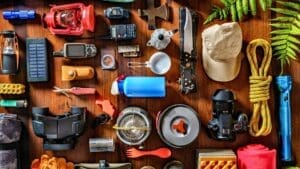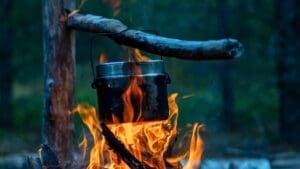How to Start a Fire with a Ferro Rod in Any Weather
In the wild, few skills are more empowering than making fire. While lighters and matches can fail in wet or windy conditions, a ferrocerium rod — commonly called a “ferro rod” — will throw sparks in any weather, making it one of the most reliable fire-starting tools for bushcraft, camping, and survival. Mastering the ferro rod ensures that no matter how damp, cold, or stormy it gets, you’ll always have the power to create fire.
What is a Ferro Rod?
A ferro rod is a metal alloy stick that produces hot sparks when scraped with a sharp edge. Unlike flint and steel, which creates a single spark, a ferro rod showers sparks that burn at over 3,000°C (5,400°F) — hot enough to ignite most natural tinders even in less-than-ideal conditions.
Key advantages:
- Works when wet — water won’t ruin a ferro rod.
- Durable — a quality ferro rod can last for thousands of strikes.
- Lightweight — small enough to carry as a backup in any kit.
- Wind resistant — sparks fly even in high gusts.
Essential Gear for Fire Starting
Before you strike sparks, gather the right materials:
- Tinder: Dry, fluffy material that catches sparks easily. Examples include birch bark, dry grass, cattail fluff, fatwood shavings, feather sticks, or cotton balls dipped in petroleum jelly.
- Kindling: Small sticks ranging from pencil-thin to thumb-thick. Dry and dead branches work best.
- Fuel: Larger logs and splits that will keep your fire burning once it’s established.
- Tools: A ferro rod and striker (or the back of a knife spine). A small hatchet or saw is useful for preparing wood.
Pro tip: Always stage your wood in advance. Fire building fails more often from poor preparation than poor sparks.
Step 1: Prepare Your Fire Lay
Before striking sparks, build the structure your fire will grow in. Common fire lays for ferro rod ignition include:
- Teepee: Tinder at the center, kindling stacked in a cone above. Great for fast ignition.
- Log Cabin: Tinder inside a small “square” of stacked sticks. Provides structure and airflow.
- Lean-To: Tinder placed under a stick angled against a log. Ideal for windy conditions.
Tip: Build small at first. Large logs smother weak flames. Start with fine tinder and gradually scale up.
Step 2: Prepare Your Tinder Bundle
The tinder bundle is where the sparks will land and catch flame. It should be:
- Light, fluffy, and dry.
- Arranged in a loose “nest” shape with a small depression in the middle to catch sparks.
- Fine shavings or fibers on the inside, coarser material on the outside.
Field-tested favorites: Birch bark curls, fatwood shavings, and cotton balls with petroleum jelly. These ignite quickly under a ferro rod shower.
Step 3: Striking the Ferro Rod
Technique matters as much as materials. Here’s how to strike effectively:
- Grip: Hold the ferro rod firmly at a 45° angle, close to the tinder bundle.
- Strike method: Instead of pushing the striker forward, pull the ferro rod back against the striker. This keeps your tinder from being scattered by the motion.
- Pressure: Apply firm, controlled pressure to shave sparks off the rod.
- Consistency: Multiple strikes may be needed. Aim sparks into the tinder’s heart.
Pro tip: For wet or stubborn tinder, create a small pile of scraped ferrocerium dust directly onto the tinder. Then strike — the dust will flare like a match head.
Step 4: Nurture the Flame
Once your tinder bundle catches, treat it carefully:
- Gently cup your hands and blow steadily to feed oxygen.
- Place the flaming bundle under your prepared kindling structure.
- Gradually add larger sticks as the flame strengthens.
Rule of thumb: Never add fuel larger than the fire can consume. Grow your fire step by step.
Wet Weather Fire Starting
Starting a fire with a ferro rod in rain or snow is entirely possible if you adapt:
- Find dry wood: Split logs to access the dry inner core. Look under logs, stumps, or dense conifers for dry sticks.
- Use bark: Birch and cedar bark ignite even when damp due to natural oils.
- Elevate your fire: Build on a base of dry logs or rocks to keep tinder off wet ground.
- Wind block: Use your body, a tarp, or rocks to shelter sparks from gusts.
Bonus hack: Carry a small tin of char cloth or fatwood shavings in a waterproof bag. They are nearly foolproof starters in wet weather.
Common Mistakes to Avoid
- Using damp or green wood — fire fails more often from poor fuel than weak sparks.
- Striking too far from the tinder — sparks need to fall directly into the bundle.
- Building the fire too big, too fast — smothering flames with heavy logs.
- Not preparing enough tinder — always gather twice as much as you think you’ll need.
Recommended Gear for Ferro Rod Fire Starting
- Ferro Rods: Large-diameter rods last longer and produce bigger sparks.
- Strikers: Dedicated steel strikers or the 90° spine of a survival knife.
- Tinder Carriers: Waterproof pouches or tins for cotton balls, fatwood, or char cloth.
- Knives & Tools: Fixed-blade bushcraft knives, small axes, or folding saws for wood prep.
Final Thoughts
Fire making with a ferro rod is more than a survival skill — it’s a connection to primal self-reliance. When the lighter runs dry and the matches are gone, a ferro rod will still spark in rain, wind, or snow. With preparation, patience, and practice, you’ll not only survive in the wild — you’ll thrive, confident that fire is always within your reach.
Sparks, patience, and respect for the flame — that’s the recipe for success.








